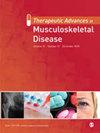The sequential antifracturative treatment: a meta-analysis of randomized clinical trials
IF 3.4
2区 医学
Q2 RHEUMATOLOGY
引用次数: 0
Abstract
Background:Subjects with a fragility fracture have an increased risk of a new fracture and should receive effective strategies to prevent new events. The medium-term to long-term strategy should be scheduled by considering the mechanisms of action in therapy and the estimated fracture risk.Objective:A systematic review was conducted to evaluate the sequential strategy in patients with or at risk of a fragility fracture in the context of the development of the Italian Guidelines.Design:Systematic review and meta-analysis.Data sources and methods:PubMed, Embase, and the Cochrane Library were investigated up to February 2021 to update the search of a recent systematic review. Randomized clinical trials (RCTs) that analyzed the sequential therapy of antiresorptive, anabolic treatment, or placebo in patients with or at risk of a fragility fracture were eligible. Three authors independently extracted data and appraised the risk of bias in the included studies. The quality of evidence was assessed using the Grading of Recommendations Assessment, Development, and Evaluation methodology. Effect sizes were pooled in a meta-analysis using fixed-effects models. The primary outcome was the risk of refracture, while the secondary outcome was the bone mineral density (BMD) change.Results:In all, 17 RCTs, ranging from low to high quality, met our inclusion criteria. A significantly reduced risk of fracture was detected at (i) 12 or 24 months after the switch from romosozumab to denosumab versus placebo to denosumab; (ii) 30 months from teriparatide to bisphosphonates versus placebo to bisphosphonates; and (iii) 12 months from romosozumab to alendronate versus the only alendronate therapy (specifically for vertebral fractures). In general, at 2 years after the switch from anabolic to antiresorptive drugs, a weighted BMD was increased at the lumbar spine, total hip, and femoral neck site.Conclusion:The Task Force formulated recommendations on sequential therapy, which is the first treatment with anabolic drugs or ‘bone builders’ in patients with very high or imminent risk of fracture.连续抗骨折治疗:随机临床试验荟萃分析
背景:脆性骨折患者发生新骨折的风险增加,应采取有效策略预防新骨折的发生。设计:系统综述和荟萃分析。数据来源和方法:对截至 2021 年 2 月的 PubMed、Embase 和 Cochrane 图书馆进行了调查,以更新近期系统综述的搜索结果。符合条件的随机临床试验(RCT)分析了脆性骨折患者或有脆性骨折风险的患者的抗骨吸收、同化治疗或安慰剂序贯疗法。三位作者独立提取数据并评估了纳入研究的偏倚风险。证据质量采用建议分级评估、制定和评价方法进行评估。在荟萃分析中使用固定效应模型对效应大小进行了汇总。主要研究结果是骨折风险,次要研究结果是骨矿物质密度(BMD)变化。在(i)从罗莫索单抗到地诺单抗与从安慰剂到地诺单抗的转换后12个月或24个月,(ii)从特立帕肽到双膦酸盐与从安慰剂到双膦酸盐的转换后30个月,以及(iii)从罗莫索单抗到阿仑膦酸盐与唯一的阿仑膦酸盐疗法(特别是针对椎体骨折)的转换后12个月或24个月,发现骨折风险明显降低。总的来说,在从同化药物转为抗骨吸收药物 2 年后,腰椎、全髋和股骨颈部位的加权 BMD 均有所增加。
本文章由计算机程序翻译,如有差异,请以英文原文为准。
求助全文
约1分钟内获得全文
求助全文
来源期刊

Therapeutic Advances in Musculoskeletal Disease
Medicine-Rheumatology
CiteScore
6.80
自引率
4.80%
发文量
132
审稿时长
18 weeks
期刊介绍:
Therapeutic Advances in Musculoskeletal Disease delivers the highest quality peer-reviewed articles, reviews, and scholarly comment on pioneering efforts and innovative studies across all areas of musculoskeletal disease.
 求助内容:
求助内容: 应助结果提醒方式:
应助结果提醒方式:


